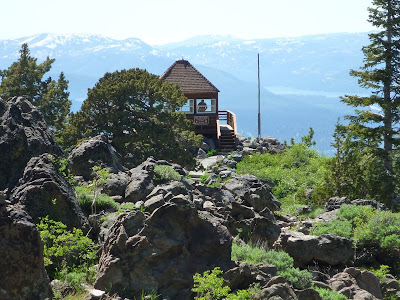 One, two, three ... the Spanish Springs Trailhead has been dedicated in the presence of a small crowd on a sunny Saturday morning. This trailhead will provide future access to trails through open space along the west side of Spanish Springs Valley in Washoe County, Nevada. Currently, there are existing dirt roads and crisscrossing tracks. Trails still have to be designed and built. The site offers great views across the valley to Sugarloaf Peak and to the Pah Rah and Virginia Range further southeast. Spanish Springs Trailhead may eventually be a gateway for hikers, mountain bikers and horse riders to an area much larger than the currently targeted 330 acres, which are part of Bureau of Land Management (BLM) land. These acres are surrounded by further BLM land and the Reno Sparks Indian Colony to the north. Hopefully, trail connections to Lemmon Valley and the envisioned Sun Valley Rim Trail will become true.
One, two, three ... the Spanish Springs Trailhead has been dedicated in the presence of a small crowd on a sunny Saturday morning. This trailhead will provide future access to trails through open space along the west side of Spanish Springs Valley in Washoe County, Nevada. Currently, there are existing dirt roads and crisscrossing tracks. Trails still have to be designed and built. The site offers great views across the valley to Sugarloaf Peak and to the Pah Rah and Virginia Range further southeast. Spanish Springs Trailhead may eventually be a gateway for hikers, mountain bikers and horse riders to an area much larger than the currently targeted 330 acres, which are part of Bureau of Land Management (BLM) land. These acres are surrounded by further BLM land and the Reno Sparks Indian Colony to the north. Hopefully, trail connections to Lemmon Valley and the envisioned Sun Valley Rim Trail will become true.
Getting there
From Sparks drive north on Highway 445 (Pyramid Highway), pass Lazy 5 Regional Park and turn left on Eagle Canyon Driven. After about two miles turn right on West Calle de la Plata (direction for Spanish Springs Airport) and then turn left on Fuggles Drive. Carefully drive through the neighborhood, turn left on Kinglet Drive, drive uphill to the end of the road and housing development and find parking to your right.





























































